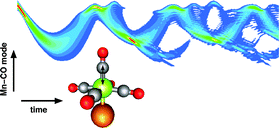Chirp-driven vibrational distribution in transition metal carbonyl complexes
Abstract
In this theoretical study vibrational ladder climbing in transition metal carbonyl complexes, as a possible means to initialize chemical ground state reactions, and the resulting vibrational population distribution using chirped mid-infrared femtosecond laser pulses is investigated. Our model system is MnBr(CO)5, a strong IR-absorber within an experimentally easily accessible wavelength region. Special emphasis is put on the perturbation due to additional vibrational modes, especially on one, which allows dissociation at low energies. The related potential energy surface for the three representative modes is calculated, whereon quantum dynamics calculations, including the laser–molecule interaction, are performed. No significant coupling could be detected, neither in the bound, nor in the dissociative region. Contrarily, we found a dynamical barrier even for energies high above the dissociation limit. Different vibrational population distributions after the laser excitation of the CO stretching mode could be generated in dependence of the chirp parameters. Based on these findings we simulated the laser excitation corresponding to an experiment by M. Joffre et al., Proc. Natl. Acad. Ssi. U. S. A., 2004, 101(36), 13216–13220, where coherent vibrational ladder climbing in carboxyhemoglobin was demonstrated and we could offer an explanation for an open question, concerning the interpretation of the spectroscopic data.


 Please wait while we load your content...
Please wait while we load your content...